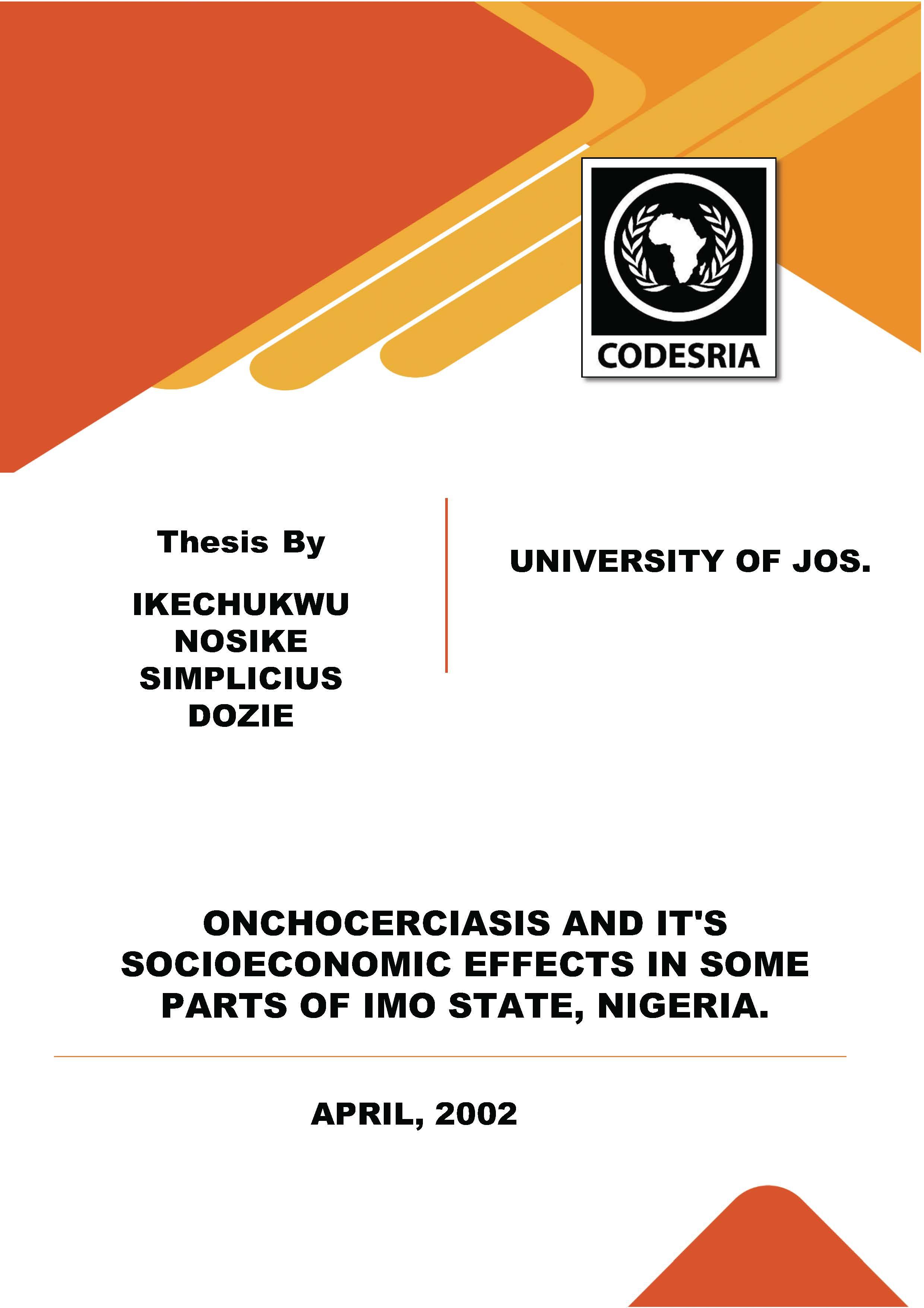Onchocerciasis and its Socioeconomic Effects in some Parts of IMO State, Nigeria
Keywords:
Onchocerciasis, economic implications, social implications, parasitic diseases, NigeriaSynopsis
Human infection with Onchocerca volvulus and its socioeconomic conséquences were investigated in parts of the Imo River Basin of Nigeria between March 1996 and December 2000 using standard parasitological and socioeconomic methods. The Knowledge, attitude and perception of the inhabitants to the disease and its treatment with ivermectin as weil as the microbial agents associated with onchocercal skin lésions were also determined. Of the 7,348 persons randomly examined by the skin snip method, 1,655(22.5%) were infected with microfilariae of 0. volvulus. The prevalence of infection differed (P<0.05) between communities in the upper Imo River Basin (26.8%) and the middle Imo River Basin (19.0%). A mean microfilarial density, 20.1mf/ss was obtained. There was no significant différence (P>0.05) in sexrelated infection. 22.9% in maies and 22.1% in females. Classical symptoms of the disease were observed in varying rates. Less than half of the viliagers (48.2%) used to assess community Knowledge knew about the disease and only about 5% attributed transmission of infection to the vector fly, Simulium damnosum. Persons afflicted with visible manifestations like dermatitis, lymphoedema (limb) and blindness were notconsidered good for marriages or hired as farm hands. The percentage drop in school attendance of pupils was higher in househoids where family heads had severe onchocercal skin disease (OSD) (4.9%) than in househoids with family heads of non-OSD status (2.1%). The total revenue loss due to direct costs of treatment and man-days lost to incapacitation was remotely estimated at HQ2 million annualiy. 79.8% persons accepted ivermectin, while 68.8% complied with yearly treatment. This was attributed to severai factors Including effective grassroots mobilization, community participation in the planning and implementation of the programme and perceived efficacy of the drug. Microorganisms isolated from excoriated onchocercal skin lésions included Staphylococcus aureus (89.9%), Streptococcus pyogenes (50.8%), Pseudomonas aeruginosa (21.8%),
Escherichia coli (60.7%), Bacteroides spp (11.5%) and Clostridium spp (3.3%). Majority of these organisms exhibited moderate to marked susceptibilities to broad spectrum antibiotics iike Tarivid, Ciproxin and its derivative, Norfloxacin. The results of the study have shown that despite the mesoendemic nature of onchocerciasis in the study area, it is still a serious problemconsidering the associated skin lésions, gross lymphatic pathologies and their négative impact on marriage, productivity and attendance to school. These findings underscore the need to sustain treatment with ivermectin and possibly on a semi-annual basis.
Downloads
References
Abanobi, O.C, Anosike, J.C. and Edungbola, L.D (1994). Observations on deworming effect of mectizan on intestinal helminths during mass treatment in Imo State, Nigeria. Nigerian Journal.of Parasitology, 4:11-15.
Abiose, A, Jones, 8.R., Consens, S. N., Murdoch, 1., Cassels-Brown, A., Babalola, E.O., Alexander, N.D.E., Nuhu, Evans, J., Ibrahim, U.F. and Mahmood, A.O. (1993). Reduction in incidence of optic nerve disease with annual ivermectin to control onchocerciasis. Lancet; 130-134.
Abiose, A, Murdoch, I., Babalola, O.E., Consens, S., Liman, I., Oyema, J., and Jones, B.R, (1994).
The distribution and aetiology of blindness and visual impairment in mesoendemic onchocercal communities, Kaduna State,Nigeria. British Journal of Ophthalmology, 78:8-13.
Abiose, A (1998). Onchocercal eye disease and the impact of Mectizan treatment.
Annals of Tropical Medicine and Parasitology, 92:S11-S22.
Adeyemi, K.S. (1990). Modelling the agricultural impact of tropical diseases: Guinea worm case study. Nigerian Journal of Parasitology, 11:3-11.
Akogun, O.B. (1989). Parasitic worms in Nigerian folklore. Parasitology Today, 5 (2): 39.
Akogun, O.B. and Onwuliri, C.O.E. (1991). Hyperendemic onchocerciasis in the Taraba River Valley of Gongola State (Old Adamawa Province). Annals de Parasitologie Humaine et Compare'e, 66: 22-26.
Amazigo, U.O. (1994). Detrimental effects of onchocerciasis on marriage age and breast feeding. Tropical and Geographical Medicine, 49:322-325.
Amazigo, U.O. and Obikeze, D.S. (1991). Sociocultural factors associated with prevalence and intensity of onchocerciasis and onchodermatitis among adolescent girls in rural Nigeria. Geneva: World Health Organisation.
Amuta, E.U. (1982). Some aspects of the epidemiology of onchocerciasis in 3 villages, Kaduna State of Nigeria. Proceedings of the First National Conference on Onchocerciasis, Kaduna Nigeria. pp 26-28.
Amuta, E.U. and Onwuliri, C.O.E. (1997). Anatomical distribution of 0. volvulus microfilariae in Ushongo and Okpokun LGAs of Benue State, Nigeria. West African Journal of Biological Sciences, 6(2): 109-121.
Amuta, E.U. and Onwuliri, C.O.E. (1998). Microfilariae in onchocerciasis: An Epidemiological Study in Benue State, Nigeria. West African Journal of Biological Sciences, 7:106-111.
Anderson, J., Fuglsang, H. and Zubaidy, A (1973). Onchocerciasis in Yemen with special reference to Sowda. Transactions of the Royal Society of Tropical Medicine and Hygiene, 67:30-31.
Anderson, J., Fuglsang, H., Hamilton, P.J.S. and Marshall, T.F.de C. (1974a). Studies on onchocerciasis in the United Cameroon Republic.I. Comparison of populations with and without 0. volvulus. Transactions of the Royal Society of Tropfcal Medicine and Hygiene, 68:190-208.
Anserson, J., Fuglsang, H., Hamilton, P.J.S. and Marshall, T.F.de C. (1974b). Studies on onchocerciasis in the United Cameroon Republic. 11. Comparison of onchocerciasis in rainforest and Sudan savanna. Transactions of the Royal Society of Tropical Medicine and Hygiene, 68:209-222.
Anderson, R.I., Fazen, L.E. and Buck, A.A. (1975). Onchocerciasis in Guatemala. II. Microfilar1:-1e in urine, blood and sputum after diethlycarbamazine. American Journal of Tropical Medicine and Hygiene, 24:58-61.






